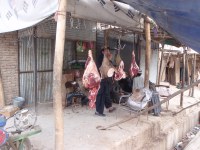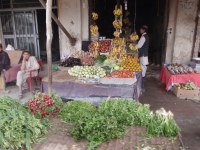Spotlight on Economics: Facilitators of Economic Growth
(Click an image below to view a high-resolution image that can be downloaded)
By Cheryl Wachenheim, Professor and Major, Minnesota Army National Guard
NDSU Agribusiness and Applied Economics Department
What motivates him? What constrains her? What can we offer? These are questions we ask ourselves as we plan missions, trainings and mentoring sessions with officials of the Government of the Islamic Republic of Afghanistan (GIRoA) and their staff.
Our National Guard Agribusiness Development Team works with the director of agriculture, irrigation and livestock in Zabul Province. Our mission includes fostering that which provides stability, improves the ability of the Afghan government to provide for its people and promotes economic growth.
In the province, farmers have been farming and traders have been trading for thousands of years. After 30 years of war and instability, plus the continuing threat by insurgents, some of the infrastructure is “broken.”
It is like going back in time before mechanization of agriculture, hybrid plants, commercial fertilizers, electricity, market information, readily available transportation, credit, standards for grading, and measurement of crops and livestock, plus other modern concepts that make agriculture in developed nations what it is today. Each of those innovations is vitally important to our agricultural production and marketing systems.
How to work in a system where these things do not exist or are prohibitively difficult or expensive to obtain or implement is a fascinating question for an economist.
It can’t be too difficult, I thought. It will be like going back to more simple times. We understand the economics, we are armed with the knowledge of “what could be” and we can help provide the resources. However, the reality is that it is very slow going because of the lack of infrastructure to support the production and marketing systems in the province. Almost every day we encounter the reality that the assumptions we make as developed-world economists do not hold.
At home, we have well-developed markets supported by competitively available, wide-reaching transportation and storage, and accessible and inexpensive credit. Here in Afghanistan, they function with a single paved national highway. The transportation of goods is expensive, in part, because the highway is traveled with the constant threat of improvised explosive devices blowing up and the insurgents who place them there. Many of the bridges are gone, so traffic does a work-around or vehicles must transverse coalition forces’ engineer-built bridges. Regular checkpoints and convoys make for slow going.
It is not just the roads that make the movement of products difficult. Products are hauled in nonrefrigerated trucks to a market that may or may not provide a better price than could be obtained by farmers selling their produce while still in the field. This is because market prices are transient and generally not readily available through the radio or other means.
In addition to the risk of moving products in hopes of a better price elsewhere, poverty and the lack of credit sometimes makes it necessary to sell products before or at the time of harvest. Cash is required by farmers for subsistence. Lack of credit also makes it difficult for farmers and vendors to store products, even in places where storage is or could be available and maintained.
In the U.S., we have rules and the processes and institutions to enforce them. Even when we are motivated by self-interest, we are policed, so we generally do the right thing. It is a relatively level playing field.
Is there lobbying in the U.S.? Yes. Are folks from time to time known to bend or even break the rules? Yes. However, the difference is that we generally trust folks to play by the rules. We make our production and marketing decisions assuming the market will be accessible and fair for all.
In southern Afghanistan, deals often are made by a handshake, and many disputes are handled at the village level, with residents deferring to the village or tribal elder. Relationships are important, but in the absence of security and with a considerable number of people living without their basic essential needs being met, rules tend to be broken. In a country that was under strict Taliban rule for a decade, here in southern Afghanistan, there is surprisingly little that would facilitate a functioning market system.
Can we still apply economic concepts to facilitate market development? Yes, we can. We focus on making a difference where we can. We work to improve the availability of market information, such as radio messaging, so producers and traders can make informed decisions with less risk. We work with Afghan security forces to improve security to allow for freedom of people and product movement. We help create and improve access to credit so entrepreneurs can purchase the resources necessary to produce and facilitate cash flow needs when storage is adopted as a means to increase sale prices. We work to bring people up from a level of bare subsistence so they are willing and able to take risks.
As elsewhere, there are the basic economic concepts. We can start with the idea that people are motivated by self-interest and adjust from there. We can invest our money and expertise into sustainable projects so that, once we leave, businesses will not just be creating jobs because they are subsidized but will continue to generate economic activity and jobs long after we leave because they are profitable.
By working to help Afghans and the GIRoA improve market infrastructure, we enhance their ability for economic growth.
NDSU Agriculture Communication – June 20, 2012
| Source: | Cheryl Wachenheim, (701) 231-7452, cheryl.wachenheim@ndsu.edu |
|---|---|
| Editor: | Rich Mattern, (701) 231-6136, richard.mattern@ndsu.edu |





